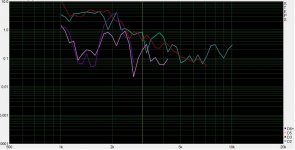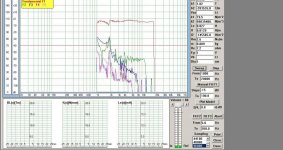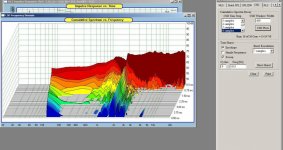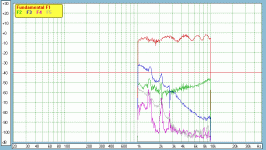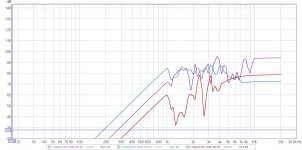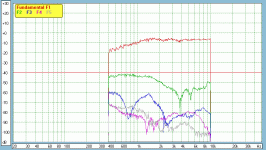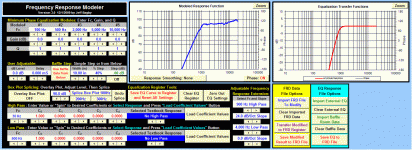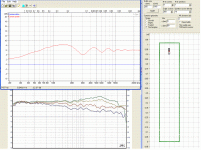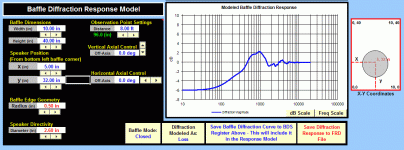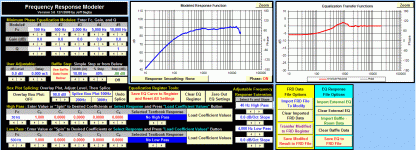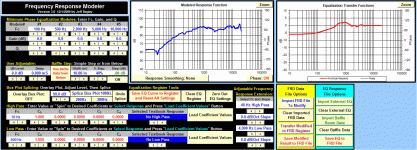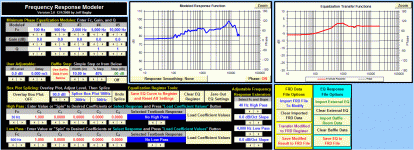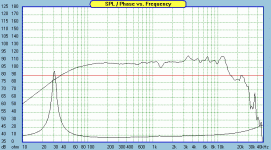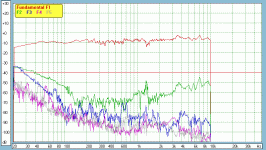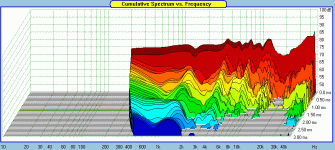Just like you I have been interested in ribbons for a while. I have always wanted to build a loudspeaker using a pair, just to see what, if anything, the hype is all about. Trouble is I'm yet to find a small, affordable device that could be used with a small mid/bass or full ranger that could give a dome a decent run for its money.
Is there some reason why you want a frequency response extending up to 40kHz? I'd be surprised if you could hear anything beyond around 15kHz. Adding to this the vast majority of music out there has a brick wall filter present that prevents anything from above around 22kHz from even being present on your recording medium. Then there's the fact that most microphones wont capture much above 20kHz either...
Ignoring the above though the R3004/602010 from Scanspeak will do what you're after, but at a price.
Is there some reason why you want a frequency response extending up to 40kHz? I'd be surprised if you could hear anything beyond around 15kHz. Adding to this the vast majority of music out there has a brick wall filter present that prevents anything from above around 22kHz from even being present on your recording medium. Then there's the fact that most microphones wont capture much above 20kHz either...
Ignoring the above though the R3004/602010 from Scanspeak will do what you're after, but at a price.
Of course the harmonic distortion of a ribbon's raw FR looks horrible. The question is, how does it look when it's properly filtered?
Graph's below:
1) Fountek CD3.5H THD by audioexcite
2) Fountek CD3.5H HD measured by a 3rd party (I unfortunately forget who I copied these from now)
3) Fountek CD3.5H CSD
4) Fountek CD2 HD by Zaph
5) Fountek CD3.5H THD with LR4 HP @ 4500Hz and notch filtered at 2000Hz
6) SB 29RDNC for comparison
Comparing audioexcite's measurements and Zaph's measurement of the CD2 with the 3rd party's measurements suggests to me that they don't hurt for accuracy. But since they were easier to trace, I've used audioexcite's THD curves for the 5th graph but had to change the scale: 80dB is about .1% or about -80dB in the other charts. 100dB is at about -60dB and so on.
And with the filters in place, the CD3.5H 's 3rd order distortion (which along with the 5th is the most egregious) actually remains at or below just about the -80dB mark both before and after the 4500Hz xo point which isn't too shabby actually. Looking at the SB 29RDNC, except for 2nd order they look fairly comparable. And above 2000Hz, the CD3.5H is showing fantastically minimal diaphragm resonances in the CSD plot.
So unless I've made a grave error somewhere or my understanding of harmonic distortion is faulty, I wouldn't be throwing the ribbon out of contention yet. But the center to center spacing is still a problem at the higher xo point so it does call for a smaller mid but there are always compromises. And in fact I see that rule of thumb broken so often that I still consider the NE123 a possible match with it. Mind you I don't disagree with 5th that the Peerless 6.5" + Satori 13P-8 + something like the SB29 tweeter would make a great speaker.
spark, you mentioned looking for a flat FR a couple of times now but in reality what you want is for the manufacturers' graphs plus your cabinet's baffle diffraction response when they are added together to be decently flat and/or smooth. And I say "and/or smooth" because I don't think you can see yet that the FR of something like the Scan 10F which is smooth but has a rather sharp elbow in it's FR is actually very easy to correct in the xo to achieve a flat response.
What I usually do at this point when I'm looking at several driver contenders is to trace the different FR's and then use Jeff Bagby's Response Modeler to set up your cabinet baffle diffraction in the bottom section and then load in the different drivers to see what the FR and diffraction look like together. The program also allows you to get a quick look at what different xo's will do as well as to try some eq type filtering if that's needed.
If I still have multiple driver contenders at this point, then I start doing full xo sims to get a feel for which drivers work better together, for what the xo is going to look like and to see if I can get the drivers' phase to line up properly. All of this before I'm willing to start buying anything.
Maybe have a go at it and see what you can come up with.
Graph's below:
1) Fountek CD3.5H THD by audioexcite
2) Fountek CD3.5H HD measured by a 3rd party (I unfortunately forget who I copied these from now)
3) Fountek CD3.5H CSD
4) Fountek CD2 HD by Zaph
5) Fountek CD3.5H THD with LR4 HP @ 4500Hz and notch filtered at 2000Hz
6) SB 29RDNC for comparison
Comparing audioexcite's measurements and Zaph's measurement of the CD2 with the 3rd party's measurements suggests to me that they don't hurt for accuracy. But since they were easier to trace, I've used audioexcite's THD curves for the 5th graph but had to change the scale: 80dB is about .1% or about -80dB in the other charts. 100dB is at about -60dB and so on.
And with the filters in place, the CD3.5H 's 3rd order distortion (which along with the 5th is the most egregious) actually remains at or below just about the -80dB mark both before and after the 4500Hz xo point which isn't too shabby actually. Looking at the SB 29RDNC, except for 2nd order they look fairly comparable. And above 2000Hz, the CD3.5H is showing fantastically minimal diaphragm resonances in the CSD plot.
So unless I've made a grave error somewhere or my understanding of harmonic distortion is faulty, I wouldn't be throwing the ribbon out of contention yet. But the center to center spacing is still a problem at the higher xo point so it does call for a smaller mid but there are always compromises. And in fact I see that rule of thumb broken so often that I still consider the NE123 a possible match with it. Mind you I don't disagree with 5th that the Peerless 6.5" + Satori 13P-8 + something like the SB29 tweeter would make a great speaker.
spark, you mentioned looking for a flat FR a couple of times now but in reality what you want is for the manufacturers' graphs plus your cabinet's baffle diffraction response when they are added together to be decently flat and/or smooth. And I say "and/or smooth" because I don't think you can see yet that the FR of something like the Scan 10F which is smooth but has a rather sharp elbow in it's FR is actually very easy to correct in the xo to achieve a flat response.
What I usually do at this point when I'm looking at several driver contenders is to trace the different FR's and then use Jeff Bagby's Response Modeler to set up your cabinet baffle diffraction in the bottom section and then load in the different drivers to see what the FR and diffraction look like together. The program also allows you to get a quick look at what different xo's will do as well as to try some eq type filtering if that's needed.
If I still have multiple driver contenders at this point, then I start doing full xo sims to get a feel for which drivers work better together, for what the xo is going to look like and to see if I can get the drivers' phase to line up properly. All of this before I'm willing to start buying anything.
Maybe have a go at it and see what you can come up with.
Attachments
spark, you mentioned looking for a flat FR a couple of times now but in reality what you want is for the manufacturers' graphs plus your cabinet's baffle diffraction response when they are added together to be decently flat and/or smooth. And I say "and/or smooth" because I don't think you can see yet that the FR of something like the Scan 10F which is smooth but has a rather sharp elbow in it's FR is actually very easy to correct in the xo to achieve a flat response.
I guess its a combination of a couple of things. My lack of understanding that the cab can effect the FR across the whole range. Also in my mind (a little knowledge is a dangerous thing) it seems that if the manufacturer has a flat ish FR, then there's less work (electronic manipulation) required to help smooth the FR out. e.g. flat is a better starting point than rough?
Is there some reason why you want a frequency response extending up to 40kHz? I'd be surprised if you could hear anything beyond around 15kHz. Adding to this the vast majority of music out there has a brick wall filter present that prevents anything from above around 22kHz from even being present on your recording medium. Then there's the fact that most microphones wont capture much above 20kHz either...
.
My audio sources (music wise) are HQ digital and uncompressed. I know a lot of music these days is normalised to hell and back however some artists do strive to record and produce music that's natural and near to a live performance. My understanding is (based on conversations many years ago with audio engineer) that whilst the human hearing range is limited (depending on age) 20Hz-20kHz, frequencies above 20kHz reflect/combine/harmonise and fall back into the audible hearing range. i.e you can't hear above 20kHz but you can hear the effects of those sounds. So that's my line of thinking with the speaker build. Even if only a small percentage of my music is good enough to benefit from the higher frequency ranges, that's enough of a percentage for me 🙂
I do have question about the woofer. I've been trying to find distortion data for the Peerless 835025, just so I can see how that stacks up against the Satori MW16 low down. I can't seem to find anything out there? I'm happy with the Peerless 835025 choice but i'm still curious 🙂
Tweeter wise. I have a headache just trying to get my head around this, so will try and few sims and see where I get too 🙂
Closest I can find for measurements of the Peerless aluminum woofer is its nomex brother, same motor but with a different cone so I expect very similar performance. It wasn't measure below 200Hz though but you can see that it's trending downward as you go lower in frequency, probably to near 100Hz when it would typically start rising again. Best way to use it is probably below about 600-700Hz.
Those are decently good harmonic distortion results but they are definitely not as good as the Satori. But it's also half the price. So sort of depends on your priorities.
One of the things I haven't mentioned is that I have a philosophy that better drivers need better, quieter cabinets. Your existing cabinets may suit your aesthetic tastes but chances are they are not terribly well built. That is 1 area that diy has over the mass production companies - it's not that difficult to build better cabinets when you don't have a bottom line to worry about. So I would sort of be thinking in terms of the upper end of the high value drivers and leave the top end ones for your next build from scratch. Or in other words, I might save the Satoris for another go around. Just an idea anyways.
Those are decently good harmonic distortion results but they are definitely not as good as the Satori. But it's also half the price. So sort of depends on your priorities.
One of the things I haven't mentioned is that I have a philosophy that better drivers need better, quieter cabinets. Your existing cabinets may suit your aesthetic tastes but chances are they are not terribly well built. That is 1 area that diy has over the mass production companies - it's not that difficult to build better cabinets when you don't have a bottom line to worry about. So I would sort of be thinking in terms of the upper end of the high value drivers and leave the top end ones for your next build from scratch. Or in other words, I might save the Satoris for another go around. Just an idea anyways.
I guess its a combination of a couple of things. My lack of understanding that the cab can effect the FR across the whole range. Also in my mind (a little knowledge is a dangerous thing) it seems that if the manufacturer has a flat ish FR, then there's less work (electronic manipulation) required to help smooth the FR out. e.g. flat is a better starting point than rough?
Ok let's see if I can't help you out with this idea and maybe help you out with the simulation process as well.
Start by tracing the tweeter and mid FR for the drivers you're interested in. Use this program: New automatic graph tracing program - Techtalk Speaker Building, Audio, Video Discussion Forum
Then let's look at the cabinet diffraction affecting the tweeter. I'm going to use the Fountek CD3.5H as our example. Now because it's a ribbon, you need to use either the Edge or the Baffle Diffraction Simulator that I linked to previously (post 26). Image 1 is a screen capture using the Edge with the tweeter on a 8"x40" baffle, with the tweeter centered and about 36.5" up from the bottom. The problem here though is that the Edge only simulates sharp edges. So for comparison, let's look at the BDS sim in chart 2. Here I've set up the same conditions but with a 1/2" roundover on all the edges which looks about right for your speaker cabinet. Chart 3 shows you the results which are pretty much exactly the same as I got with the Edge demonstrating that a 1/2" roundover is actually kind of useless. You really need to go bigger than that to start having some significant effects at attenuating the the size of ripples.
So choose which program you want to try and then save the diffraction response as a frd file. In the case of the Edge, you'll need to trace it but you have to make sure that you set up the 6dB point as 0dB in the tracing graph (so the Edge's 0dB point will be -6dB). If you use BDS, you also have to save it with the "Ref Level (dB)" as -6dB.
Now let's look at how the tweeter and baffle effects combine together. For this you'll have to use Response Modeler. Because Fountek's FR graph stops at about 1000Hz, the 1st thing you need to do is add in the LF rolloff. So import the traced FR and then use the "Adjustable Frequency Response Extension" section. See chart 4. Save the result, clear the data and then re-import the new FR. Import you saved diffraction response to the right and you're all set. Chart 5 shows the results. Remember that if you use this tweeter, the xo point should be a minimum of about 4500Hz so you are mostly concerned with what the result looks like above this frequency, which as you can see isn't too bad except for perhaps the little dip at about 6500Hz that gets accentuated. But dips are always more benign than peaks so I would call that perfectly acceptable.
Attachments
Well jReave the bigger ribbons do perform very nicely, I saw those measurements myself a few days ago and was quite impressed.
I see you chose the better performing of the two ribbons Gornir measured for your comparison. While I agree that makes the most sense as we could consider the other one faulty who knows if that's actually the case. Above 4.5kHz the nice one is compelling but the SB dome will do that comfortably down much lower.
What bothers me is how absolutely terrible these fountek ribbons are at higher drive levels. Things really fall to bits especially with the increase in the higher order harmonics.
I know we see vertical separation often exploited but I'd always prefer not to unless the design stritcly necessitates it and if only for good technical reason, such as using a waveguide.
I see you chose the better performing of the two ribbons Gornir measured for your comparison. While I agree that makes the most sense as we could consider the other one faulty who knows if that's actually the case. Above 4.5kHz the nice one is compelling but the SB dome will do that comfortably down much lower.
What bothers me is how absolutely terrible these fountek ribbons are at higher drive levels. Things really fall to bits especially with the increase in the higher order harmonics.
I know we see vertical separation often exploited but I'd always prefer not to unless the design stritcly necessitates it and if only for good technical reason, such as using a waveguide.
Now let's look at your mid choices and baffle diffraction.
Here you just have to use Response Modeler. Start down at the bottom this time and set up your cabinet parameters (chart 1). I used a driver height of 32" this time which I think fits well for a driver the size of the Scan 10F. So back up top and import the Scan's traced FR and then click on the "Use Baffle Data from Below" button. Chart 2 shows the results and what do you know? The baffle diffraction peak happens to fill in the response right at the 10F's 'elbow' which gives you a very smooth and relatively flat FR to work with.
Next do the same for the Vifa NE123-8. Change the driver height down in the Diffraction section to 31.5" because it's a bigger driver and change the piston diameter to about 3". Back up top, import the Vifa traced FR and the new baffle diffraction response. Chart 3 shows the results. Not quite as smooth this time. You get more of a wide peak centered at about 1000Hz now. Still for a 4500Hz xo, that's not anything egregious. It will probably just take an extra notch filter to smooth that out the way you need it.
Now try the same with the Satori 13P. It's not exactly a great combo with the ribbon tweeter for the reasons that 5th stated previously, but let's look at it anyways. First change the driver height again to about 31" and driver piston to 3.8". Import the 2 new files up top again and chart 4 is the result (ignore the response below 100Hz btw - I haven't spliced on the box response). Very good except for the little sort of plateau between about 700Hz and 1000Hz which may again need a notch filter to bring it down.
So in your case you can't really play around with cabinet widths or the size or type of baffle edge treatment to try to adjust the results. Really all you can do is vary the driver sizes and heights. But with your given cabinet, the clear winner here in terms of the easiest response to deal with looks to be the ScanSpeak 10F.
Let me know if you have trouble with any of that.
Here you just have to use Response Modeler. Start down at the bottom this time and set up your cabinet parameters (chart 1). I used a driver height of 32" this time which I think fits well for a driver the size of the Scan 10F. So back up top and import the Scan's traced FR and then click on the "Use Baffle Data from Below" button. Chart 2 shows the results and what do you know? The baffle diffraction peak happens to fill in the response right at the 10F's 'elbow' which gives you a very smooth and relatively flat FR to work with.
Next do the same for the Vifa NE123-8. Change the driver height down in the Diffraction section to 31.5" because it's a bigger driver and change the piston diameter to about 3". Back up top, import the Vifa traced FR and the new baffle diffraction response. Chart 3 shows the results. Not quite as smooth this time. You get more of a wide peak centered at about 1000Hz now. Still for a 4500Hz xo, that's not anything egregious. It will probably just take an extra notch filter to smooth that out the way you need it.
Now try the same with the Satori 13P. It's not exactly a great combo with the ribbon tweeter for the reasons that 5th stated previously, but let's look at it anyways. First change the driver height again to about 31" and driver piston to 3.8". Import the 2 new files up top again and chart 4 is the result (ignore the response below 100Hz btw - I haven't spliced on the box response). Very good except for the little sort of plateau between about 700Hz and 1000Hz which may again need a notch filter to bring it down.
So in your case you can't really play around with cabinet widths or the size or type of baffle edge treatment to try to adjust the results. Really all you can do is vary the driver sizes and heights. But with your given cabinet, the clear winner here in terms of the easiest response to deal with looks to be the ScanSpeak 10F.
Let me know if you have trouble with any of that.
Attachments
Actually, I should have said above that you can also change the driver location sideways as well as the height. I'm not sure if it makes much difference for the mid but you might want to try it with the tweeter.
Hey 5th,
I'm hoping spark understood the point I was trying to make which was that when you look at some of the better ribbon tweeters in the context of how they are going to be used vs looking at the whole FR, the distortion profile can be quite acceptable.
Now I didn't take a close look at the distortion at the higher volume but in fact, in spark's case, he has said that he doesn't listen at very loud SPL levels. That should mean that for his situation, he shouldn't be getting any harshness with this tweeter.
But you are right, I did indeed choose the better sample in my comparisons. It seemed like a valid choice since the 3rd party measurements were also consistent with that sample as well.
But for me I also want to add some subjective info to these objective measurements. And people keep reporting how happy they are with the Fountek tweeters used in the designs I linked to before, the Speedsters and the Statement designs. Now maybe I'm wrong on this point which is fair enough, but it also seems to me that spark really wants to try a ribbon and if this isn't meant to be his ultimate build which I don't think it is (could be wrong on that point too 😉), then I think he should go for it. Not the best but very good objective measurements, coupled with many positive reviews equals a solid pass in my mind. And the CD3.5H won't break the bank either.
That's the way I'm currently looking at it anyways.
I'm hoping spark understood the point I was trying to make which was that when you look at some of the better ribbon tweeters in the context of how they are going to be used vs looking at the whole FR, the distortion profile can be quite acceptable.
Now I didn't take a close look at the distortion at the higher volume but in fact, in spark's case, he has said that he doesn't listen at very loud SPL levels. That should mean that for his situation, he shouldn't be getting any harshness with this tweeter.
But you are right, I did indeed choose the better sample in my comparisons. It seemed like a valid choice since the 3rd party measurements were also consistent with that sample as well.
But for me I also want to add some subjective info to these objective measurements. And people keep reporting how happy they are with the Fountek tweeters used in the designs I linked to before, the Speedsters and the Statement designs. Now maybe I'm wrong on this point which is fair enough, but it also seems to me that spark really wants to try a ribbon and if this isn't meant to be his ultimate build which I don't think it is (could be wrong on that point too 😉), then I think he should go for it. Not the best but very good objective measurements, coupled with many positive reviews equals a solid pass in my mind. And the CD3.5H won't break the bank either.
That's the way I'm currently looking at it anyways.
Higher level testing can be found here
??-????????
It just worries me how much the higher orders rise with drive level. I am sure that lots of people are subjectively happy with their ribbons and I am certainly not going to knock anyone who wants to try, providing the compromises are accepted, understood and design decisions are made to minimise the downsides.
To me maintaining excellent off axis performance with a degree of directivity control is what sets apart mediocre designs to those of excellence with regards to sound quality and consistency in quality over a range of environments, types of equipment and musical tastes.
Of course designing a speaker that isn't an amplifier killler is pretty important too.
For what it's worth I do like the 3.5H with its waveguide providing it performs as the better sample does. Although I would definitely want to use it with 4th order acoustic at 4-4.5kHz.
??-????????
It just worries me how much the higher orders rise with drive level. I am sure that lots of people are subjectively happy with their ribbons and I am certainly not going to knock anyone who wants to try, providing the compromises are accepted, understood and design decisions are made to minimise the downsides.
To me maintaining excellent off axis performance with a degree of directivity control is what sets apart mediocre designs to those of excellence with regards to sound quality and consistency in quality over a range of environments, types of equipment and musical tastes.
Of course designing a speaker that isn't an amplifier killler is pretty important too.
For what it's worth I do like the 3.5H with its waveguide providing it performs as the better sample does. Although I would definitely want to use it with 4th order acoustic at 4-4.5kHz.
Last edited:
Guys; thanks so much for the last few posts. It looks like my Easter weekend is sorted! I'll be digesting what you've said and playing around with diffraction sims by the looks of it 🙂
Tweeter wise my thoughts are: Domes are a safe bet and ribbons divide opinion. Ribbons may or may not work for me but in the interest of experimentation, challenge and seeing if the outsider can perform as good or better than domes.. I'm up for it, assuming the sims are all favorable of course. I feel it's a good contribution to the forum also.
Watch this space. I'll be back with a million newbie questions before long 🙂
Tweeter wise my thoughts are: Domes are a safe bet and ribbons divide opinion. Ribbons may or may not work for me but in the interest of experimentation, challenge and seeing if the outsider can perform as good or better than domes.. I'm up for it, assuming the sims are all favorable of course. I feel it's a good contribution to the forum also.
Watch this space. I'll be back with a million newbie questions before long 🙂
Interesting update regarding the Woofer.
I've spotted that the SBA Satori distortion plot graphs on Audio Excite are for a slightly different revision of the MW16. Audio Excite tested the "R" version, where as the current ones on sale are "P" versions. Visually they look the same however the FR graphs are very different between the two versions.. I'm wondering if the "P" is a revised version of the "R"?
SB Acoustics :: 6 1/2'' SATORI MW16R - OFF
6½" SATORI MW16P-8 :: SB Acoustics
I've asked SBA for any distortion data they have and a description on the differences between the "R" and "P" versions of this driver.
Update: I've also just orders a CSL Calibrated MiniDSP UMIK-1 mic. Figured that it might come in handy for this project 🙂
I've spotted that the SBA Satori distortion plot graphs on Audio Excite are for a slightly different revision of the MW16. Audio Excite tested the "R" version, where as the current ones on sale are "P" versions. Visually they look the same however the FR graphs are very different between the two versions.. I'm wondering if the "P" is a revised version of the "R"?
SB Acoustics :: 6 1/2'' SATORI MW16R - OFF
6½" SATORI MW16P-8 :: SB Acoustics
I've asked SBA for any distortion data they have and a description on the differences between the "R" and "P" versions of this driver.
Update: I've also just orders a CSL Calibrated MiniDSP UMIK-1 mic. Figured that it might come in handy for this project 🙂
Last edited:
That's an interesting catch. Between the R and the P, SB's TS parameters are exactly the same but the FR do look a bit different, but the differences are relatively minor enough that they could simply be the result of random driver or measurement variation. Or in other words, I wouldn't worry about it.
Just to make things more confusing, the measurement data that I believe most people reference for this driver is by Zaph, but now I've just noticed that that one is labeled differently as well (the MW165DC). But Zaph's FR still looks close enough to both the R and P measurements that I assume it's again essentially the same driver.
It would be interesting to hear what SB has to say about it.
Below are Zaph's measured FR, HD and CSD:
Just to make things more confusing, the measurement data that I believe most people reference for this driver is by Zaph, but now I've just noticed that that one is labeled differently as well (the MW165DC). But Zaph's FR still looks close enough to both the R and P measurements that I assume it's again essentially the same driver.
It would be interesting to hear what SB has to say about it.
Below are Zaph's measured FR, HD and CSD:
Attachments
So progress this end but have a basic question that I can't seem to find the answer for. I'm using Jeff Bagy's Response modeler and there a metric required for "speaker position" (from bottom left baffle corner). What does that mean?
Ok, so I've worked my way through the Response modeler and this is what i'm getting for the mid (MW13P)
I'm concerned by the rising FR. Is that an expected result at this stage?
An externally hosted image should be here but it was not working when we last tested it.
I'm concerned by the rising FR. Is that an expected result at this stage?
It might be helpful to post a capture of the diffraction section because your baffle diffraction FR doesn't look to be correct. You should be getting some peaking lower down in frequency for an 8" wide baffle before the response starts dropping off 6dB. Instead it's pretty much flat from about 1000Hz up. So that's basically having no effect on the driver in that frequency range. Thus, the rising response from 1000Hz up is just the original response of the driver.
For the mid responses, you should be getting the same or close to what I posted before. And because baffle diffraction is always a loss of 6dB in the lower end, yes you will always get a rising response from low to high compared with the original.
Something else to note is to be aware of the scale of FR graphs. It's pretty easy actually to change a very smooth looking FR into something much more mountainous just by changing the dB scale.
For the mid responses, you should be getting the same or close to what I posted before. And because baffle diffraction is always a loss of 6dB in the lower end, yes you will always get a rising response from low to high compared with the original.
Something else to note is to be aware of the scale of FR graphs. It's pretty easy actually to change a very smooth looking FR into something much more mountainous just by changing the dB scale.
It might be helpful to post a capture of the diffraction section because your baffle diffraction FR doesn't look to be correct. You should be getting some peaking lower down in frequency for an 8" wide baffle before the response starts dropping off 6dB. Instead it's pretty much flat from about 1000Hz up. So that's basically having no effect on the driver in that frequency range. Thus, the rising response from 1000Hz up is just the original response of the driver.
For the mid responses, you should be getting the same or close to what I posted before. And because baffle diffraction is always a loss of 6dB in the lower end, yes you will always get a rising response from low to high compared with the original.
Something else to note is to be aware of the scale of FR graphs. It's pretty easy actually to change a very smooth looking FR into something much more mountainous just by changing the dB scale.
Hmm, maybe I pressed something I wasn't supposed to before 🙂 I think it was the spice at 200hz option..
Does this look any better? I've noticed the the width of the cab is pretty fundamental to the baffle results. Changing that flattens things out..
An externally hosted image should be here but it was not working when we last tested it.
An externally hosted image should be here but it was not working when we last tested it.
Ok, let's go over how to set up the diffraction modeler.
Your cabinets are about 8" (205mm) wide probably about 40" tall. I'm not sure where you got 5.5" x 6.88" from.
x is the horizontal distance from the left cabinet edge to the center of the driver. If you center the driver on the cabinet, x will be 4". y is the vertical distance from the bottom edge to the center of the driver. The exact position of the driver is the one thing you can change in your design because you can't change your cabinet dimensions. I'll usually try to find the best position for the tweeter first because that will end up determining the height of the mid since you want them to be as close together as you can get them.
From the pictures you posted, it looks like your cabinets have about a 1/2" roundover on the edges. That's your baffle edge geometry. And the driver piston diameter is usually measured from peak to peak of the surround. If I don't have the driver in hand, I'll zoom up the pdf diagram to actual size and physically measure on my computer screen. The 13P for example has a an outside diameter of 132mm and a piston diameter of about 97mm or 3.8".
Maybe you want to try Jeff's Baffle Diffraction and Boundary Simulator first just to get comfortable with the program - it's the same thing that's in Response Modeler except you get to see a real example of the cabinet and driver you are modeling.
Your cabinets are about 8" (205mm) wide probably about 40" tall. I'm not sure where you got 5.5" x 6.88" from.
x is the horizontal distance from the left cabinet edge to the center of the driver. If you center the driver on the cabinet, x will be 4". y is the vertical distance from the bottom edge to the center of the driver. The exact position of the driver is the one thing you can change in your design because you can't change your cabinet dimensions. I'll usually try to find the best position for the tweeter first because that will end up determining the height of the mid since you want them to be as close together as you can get them.
From the pictures you posted, it looks like your cabinets have about a 1/2" roundover on the edges. That's your baffle edge geometry. And the driver piston diameter is usually measured from peak to peak of the surround. If I don't have the driver in hand, I'll zoom up the pdf diagram to actual size and physically measure on my computer screen. The 13P for example has a an outside diameter of 132mm and a piston diameter of about 97mm or 3.8".
Maybe you want to try Jeff's Baffle Diffraction and Boundary Simulator first just to get comfortable with the program - it's the same thing that's in Response Modeler except you get to see a real example of the cabinet and driver you are modeling.
Ok, let's go over how to set up the diffraction modeler.
Your cabinets are about 8" (205mm) wide probably about 40" tall. I'm not sure where you got 5.5" x 6.88" from.
x is the horizontal distance from the left cabinet edge to the center of the driver. If you center the driver on the cabinet, x will be 4". y is the vertical distance from the bottom edge to the center of the driver. The exact position of the driver is the one thing you can change in your design because you can't change your cabinet dimensions. I'll usually try to find the best position for the tweeter first because that will end up determining the height of the mid since you want them to be as close together as you can get them.
From the pictures you posted, it looks like your cabinets have about a 1/2" roundover on the edges. That's your baffle edge geometry. And the driver piston diameter is usually measured from peak to peak of the surround. If I don't have the driver in hand, I'll zoom up the pdf diagram to actual size and physically measure on my computer screen. The 13P for example has a an outside diameter of 132mm and a piston diameter of about 97mm or 3.8".
Maybe you want to try Jeff's Baffle Diffraction and Boundary Simulator first just to get comfortable with the program - it's the same thing that's in Response Modeler except you get to see a real example of the cabinet and driver you are modeling.
6.88 x 5.50 are the internal dimensions for Width and Height based on 5.6L volume. I was a bit confused by why i'm not being asked for the depth of the cab but assumes the modeler was working this out some how.
So are the baffle dimensions the external size of the whole cab? If so I still don't understand by the depth isn't being asked for... or are baffle cals the effect of the front of the cab on the response? If so, that makes more sense 🙂
Yes there is a 1/2" roundover on the edges.
Last edited:
Updated Model 🙂
So if this looks right i'll do it for each of the drivers and then play around with the height of the drivers 🙂
What do I use to combine all of the results and see a response full picture?
An externally hosted image should be here but it was not working when we last tested it.
An externally hosted image should be here but it was not working when we last tested it.
So if this looks right i'll do it for each of the drivers and then play around with the height of the drivers 🙂
What do I use to combine all of the results and see a response full picture?
- Status
- Not open for further replies.
- Home
- Loudspeakers
- Multi-Way
- 3-Way Build Project - Woofer help
